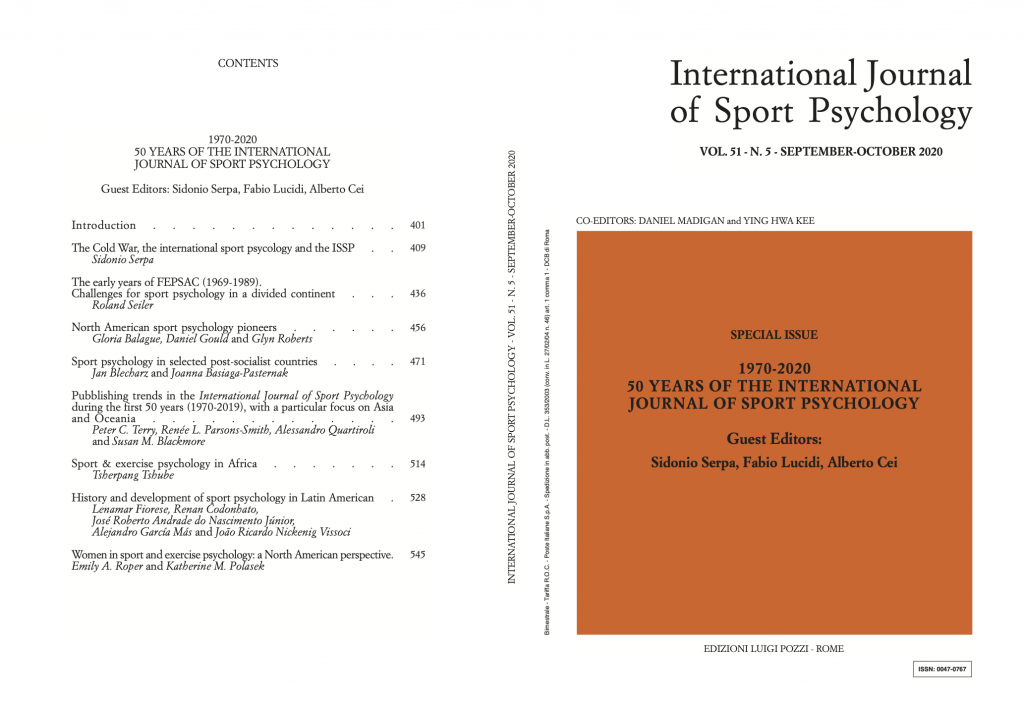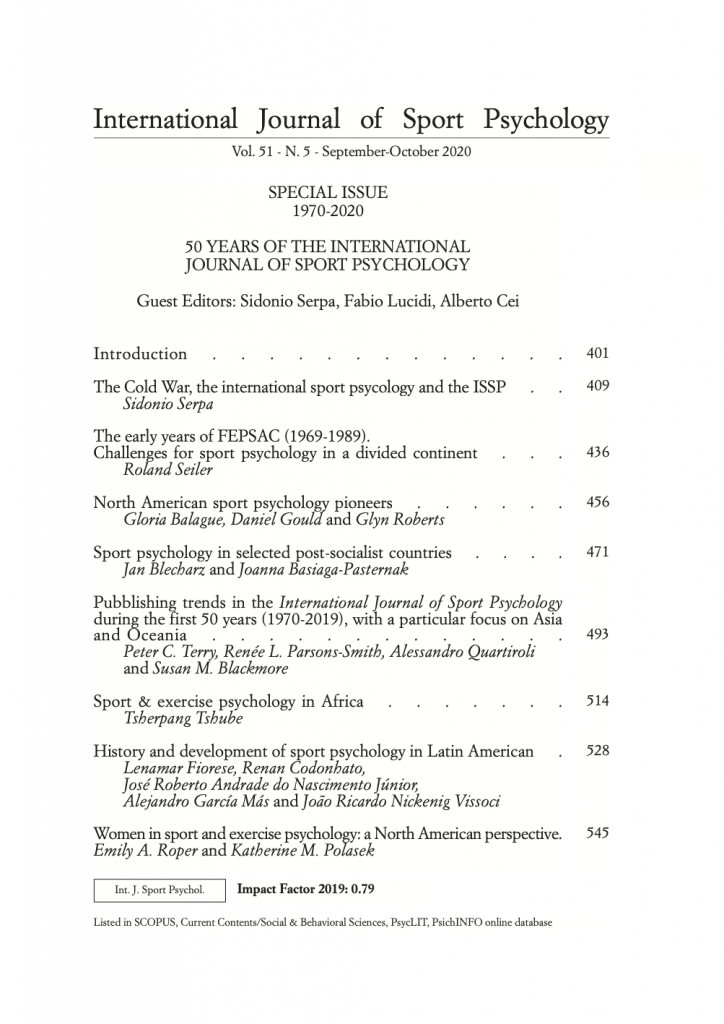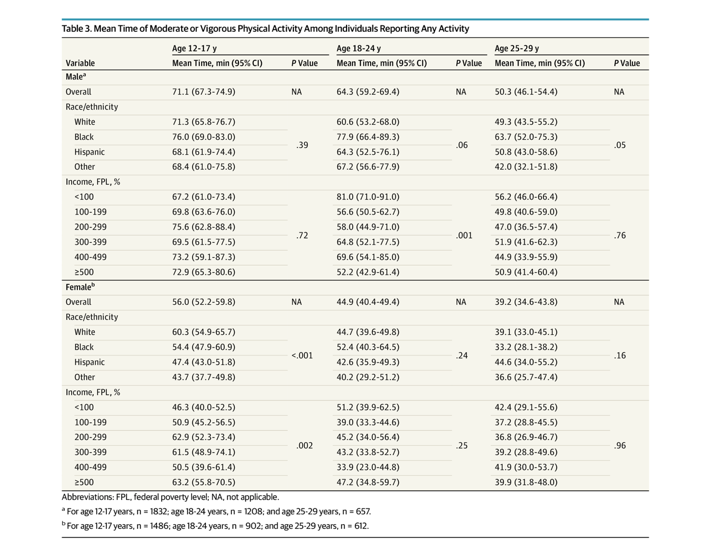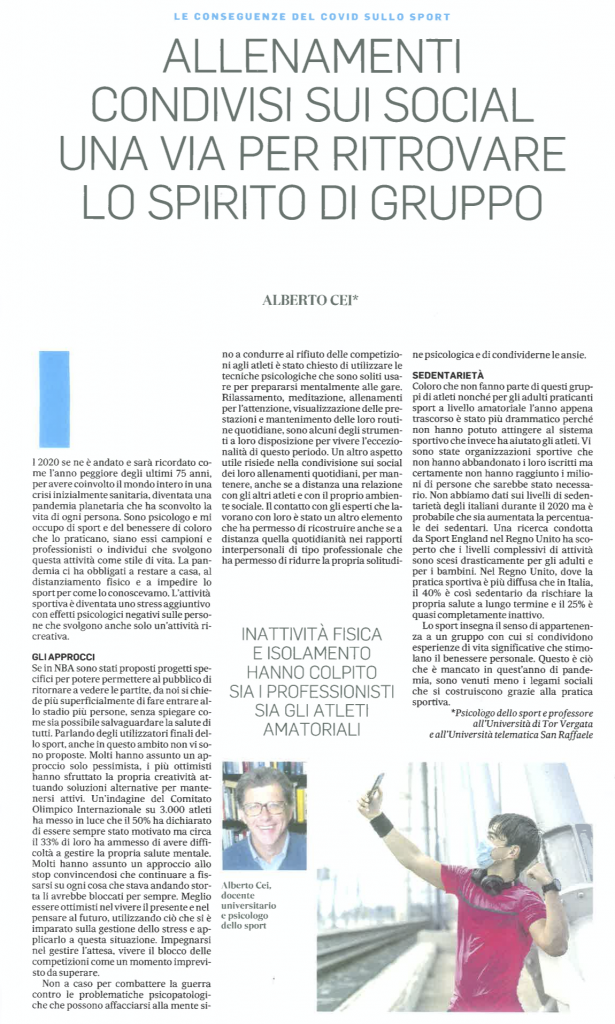SPECIAL ISSUE 1970-2020
50 YEARS OF THE INTERNATIONAL JOURNAL OF SPORT PSYCHOLOGY
Guest Editors: Sidonio Serpa, Fabio Lucidi, Alberto Cei
The IJSP: from an idea to an established Journal
ALBERTO CEI, FABIO LUCIDI, SIDÓNIO SERPA
The International Journal of Sport Psychology was the very first journal specifically committed to sport psychology, and it was created almost 10 years before the Journal of Sport Psychology that was published for the first time only in 1979, founded by Rainer Martens. Few people know about the many difficulties associated to its founding and development. It was created following a decision of the Managing Council of the recently founded Inter- national Society of Sport Psychology (ISSP), led by Ferruccio Antonelli, to be the Society’s means of communication, as well as to promote this, then, new professional and scientific field, and to enable the diffusion of research all over the World. However, it was hard to found a publisher for this world- wide diffusion scientific journal.
The Cold War, the international sport psychology and the ISSP
SIDÓNIO SERPA
The aim of this article is to document the influence of the Cold War in the development of sport psychology. This period that lasted from 1946 to 1989 deter- mined the international social and political reality following the World War II. Information for the article was gathered from personal oral and written interaction with major protagonists, as well as others that had experienced this period. Letters between the two first ISSP presidents, minutes and documents mainly from ISSP and FEPSAC were consulted. Articles, books and book chapters related to this topic were other sources for the article that discusses the influence of the Cold War in sports, the impact of this period in the development of sport psychology, the role of ISSP, and the situation determined by the end of the Cold War. Especially after the 1956 Olympics, sport victories were used as a propaganda tool, which led to the development of sport sciences, including sport psychology, in both sides of the Iron Curtin that divided the Socialist from the Capitalist parts of the World. The incep- tion of the ISSP in 1965 had an important role in promoting scientific and applied SP and making important bridges between professionals from the two blocs. After what was believed to be the end of the Cold War, a decrease in the development of SP both in the socialist countries and USA was observed, followed by an improve- ment mainly in Europe and Asia.
The early years of FEPSAC (1969-1989).
Challenges for sport psychology in a divided continent
ROLAND SEILER
Despite a growing interest in the history of Sport Psychology, little is known about the specific challenges and the working procedures in the first 20 years of FEP- SAC, when the continent of Europe was divided by the Iron Curtain. At the occasion of the 50th anniversary of FEPSAC, and based on document analysis, this article aims at shedding some light on the aims of FEPSAC’s working committees, the difficulties encountered, and the achievements made. More specifically, the Scientific Committee made attempts towards a common terminology and understanding of sport psychology concepts across the different European languages and the standardisation of tests for sport psychology. The Information and Documentation Committee was active in col- lecting and disseminating new publications. Despite considerable efforts and remark- able progresses, the long-term impact of those initiatives remained limited.
North American sport psychology pioneers
GLORIA BALAGUE, DANIEL GOULD and GLYN ROBERTS
The article describes the evolution of Sport Psychology in North America, from the very first pioneers, who planted the seeds but did not have immediate suc- cessors, to the boom of the 1980’s and 90’s.
The first part of the article is a historical recap, starting in 1895. The fast growth started in the 1980’s follows, emphasizing the impact of the Sport Psychol- ogy associations that emerged then, as well as the growth in publications.
The section describing the work of the professionals who work as sport psy- chologists, opening fronts in a variety of performance arenas, both in the US and in Canada follows.
Some of the main issues that impact the way sport psychology has evolved in North America are discussed, including the lack of coordination between the pro- fessional associations, the absence of a clear educational pathway to become a sport psychologist, and the recent changes to certification credentialing.
Sport Psychology in selected post-socialist countries
JAN BLECHARZ and JOANNA BASIAGA-PASTERNAK
The article aims to show the development of sport psychology in the selected European socialist countries. The Soviet Union was deliberately omitted, as it is the subject for a separate article. Sport psychology in particular countries has been pre- sented from the perspective of three distinct periods: the time before World War II, during the socialist period, and after the transformation. Main research areas, forms of practical support for athletes, and organizational activities have been depicted. Sport psychologists from post-socialist countries had and still have a significant influence on the shape of contemporary sport psychology.
Publishing trends in the International Journal of Sport Psychology during the First 50 years (1970-2019), with a particular focus on Asia and Oceania
PETER C. TERRY, RENÉE L. PARSONS-SMITH, ALESSANDRO QUARTIROLI and SUSAN M. BLACKMORE
To commemorate the 50th anniversary of its first issue, we explored publication trends in the International Journal of Sport Psychology (IJSP), with a particular focus on research contributions from Asia and Oceania. A descriptive analysis of all articles published in IJSP between 1970 and 2019 (N = 1,175) was conducted to identify trends related to first author gender, country, and continent. Also, an analysis of research topics by decade was conducted using Leximancer. Key findings were: (a) female first authors became more prominent over time but remained in the minority; (b) the percentage of articles from Europe and Asia increased and the percentage of articles from North America declined, although the USA and Canada have been the top contributors over the life of the journal; and (c) the focus on particular topics, espe- cially those pertaining to athletes, performance, motor learning, motivation, and teams was sustained throughout the 50-year period. Within Asia and Oceania, the 10 coun- tries publishing the most articles were, in descending order, Australia, Israel, Hong Kong, Taiwan, South Korea, New Zealand, India, Japan, Singapore, and Turkey.
Sport & exercise psychology in Africa
TSHEPANG TSHUBE
The purpose of this paper is to give an in-depth historical and current state of sport psychology in Africa. The first objective is to provide sport psychology context through a brief discussion of sport and physical activity in Africa. The second objective is to share the current state of sport psychology in each regional block (i.e., north, east, south and west). The third objective is to discuss research and consultancy, and lastly the conclusion. In order to achieve the stated objec- tives, the author reviewed academic literature and also used additional data sources such as university websites.
History and development of sport psychology in Latin America
LENAMAR FIORESE, RENAN CODONHATO, JOSÉ ROBERTO ANDRADE DO NASCIMENTO JÚNIOR, ALEJANDRO GARCÍA-MÁS and JOÃO RICARDO NICKENIG VISSOCI
The present study aimed to investigate the historical course of the sport psy- chology (SP) field and its development in Latin America. The keywords “history,” “sport psychology,” and related terms were searched for in Web of Science, Sci- enceDirect, LILACS, and Scielo databases, as well as Google Scholar and other manual searches to find scientific articles, book chapters, dissertations and other documents describing the history of SP in Latin American countries. Information was found for 15 Latin American countries. Drawing from the important data pre- sent in these works, the history of SP in this continent is presented in four periods that encompass its initial period (1930-1960), advancements in the applied and sci- entific field (1960-1980), consolidation of SP (1980-2000), and the recognition of SP (after 2000). The roots of SP in Latin America, its characteristics, factors driving its expansion and the actual state of SP are presented and discussed.
Women in sport and exercise psychology: a North American perspective
EMILY A. ROPER* and KATHERINE M. POLASEK**
Women’s contributions have had little place in the written histories of the field of sport and exercise psychology (Gill, 1995). Much of our written history of the field focuses on founders that were male, Caucasian, from the United States, and had a behavioral or experimental psychology background, with little attention to the role women, people of color, and those outside the United States played in the field’s his- tory and development (Krane & Whaley, 2010). Within this paper, we provide an overview of the literature devoted to North American women’s career experiences in the field of sport and exercise psychology, followed by a discussion of the history of feminist sport psychology and its influence on studying and acknowledging women in the field, as well as women’s experiences in sport and exercise. We then address the relative absence of documentation devoted to women’s contributions to the field out- side of North America. Lastly, we discuss the importance of female role models and mentoring women in sport and exercise psychology.








